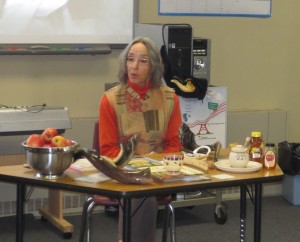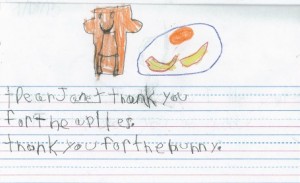One of the great parts of working at Intermountain as the chaplain is that I get to work with kids of various faith backgrounds, and I get to minister alongside the very skilled and creative leader of the local Jewish community, our Jewish Educator, Janet Tatz. It’s been fun to collaborate with her on any number of joint chapel services and to observe the innovation and creativity she brings to working with our Jewish students in residence.
 Recently, Janet had the opportunity to speak in our school’s cultural education classes about the significance of Rosh Hashanah and connecting its importance to the work the children are doing on campus. She brought her Shofar and blew it for the students while they were gathered for their cultural education class.
Recently, Janet had the opportunity to speak in our school’s cultural education classes about the significance of Rosh Hashanah and connecting its importance to the work the children are doing on campus. She brought her Shofar and blew it for the students while they were gathered for their cultural education class.
Janet had worked with two of our Jewish students for a number of weeks on learning how to blow the Shofar, and to their great delight, they were both able to blow the Shofar for their classmates and share a little about their family’s faith traditions around Rosh Hashanah.
The students in our youngest class, the first through third graders, took time to write thank you notes to Janet for her sharing in the traditional observances around Rosh Hashanah. This  included sharing apples and honey, which was a great hit with the kids, as you might imagine!
included sharing apples and honey, which was a great hit with the kids, as you might imagine!
Here’s a word from Janet herself about the recent celebrations and how Rosh Hashanah fits into a larger season of festivals and observances:
“Welcome to the year 5776!
According to the Jewish tradition and (lunar) calendar, Jews around the world celebrated Rosh HaShanah (literally the Head of the Year or Jewish New Year) earlier this month. This is a time of celebration, renewal and well-wishing in addition to being the beginning of a ten day long time of introspection, culminating in the most holy day in the Jewish year cycle: Yom Kippur, the Day of Atonement. While contemplating how one has or has not “missed the mark” in regards to being fully present in one’s life, as well as being honest, compassionate and caring, we ask forgiveness of others who we might have wronged, and promise to do better in the year ahead. The power of the holiday is enahnced by fasting, spending the day in synagogue praying, and making amends.
As soon as Rosh HaShanah and Yom Kippur are concluded, the holiday of Sukkot ( Feast of Booths or Feast of the Tabernacle) is celebrated. We build sukkot, temporary outdoor shelters, that both celebrate the Fall harvest as well as remind us of the temporal nature of our time here on this earth.
This seven day festival, and the Jewish month of Tishrei conclude with Simchat Torah, the fourth of this month long High Holiday season. Simchat Torah marks the conclusion of the year long cycle of reading the Torah (Five Books of Moses) and commences with the rereading of the books, with Genesis/ the Story of Creation. This joyous holiday is celebrated with song, dancing and much merriment. All in all, a meaningful and awe inspiring part of the Jewish year cycle.
Shana tova: a happy and healthy New Year to you and yours!”
–Janet Tatz, Jewish Educator

 Click here to subscribe to our RSS feed with your favorite email client and be alerted to new articles.
Click here to subscribe to our RSS feed with your favorite email client and be alerted to new articles.